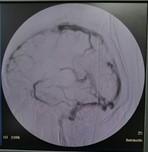Usted está aquí
Peruvian Journal of Neurosurgery
Venous sinus thrombosis secondary to severe traumatic brain injury. case report
MARCOS VILCA A., MARCO MELGAREJO P., ERMITAÑO BAUTISTA C., CARLOS PALACIOS P., YURIKO VILLAREAL H.
Abstract (Spanish) ||
Full Text ||
PDF (Spanish)
ABSTRACT
Introduction: Cerebral venous thrombosis (CVT) is a rare type of cerebrovascular disease that can occur at any age and represents 0.5% to 1.5% of the total.1 Superior sagittal venous sinus thrombosis (SSVST) secondary to brain injury (BTI) is reported worldwide only as single cases or in small series.3,4 Headache is the most frequent symptom (90%). The most common focal signs are aphasia and hemiparesis. Papilledema occurs in 25% of cases and epilepsy in about 40%.1,4 Diagnosis is made by venous phase angiography, or by magnetic resonance imaging (MRI) with gadolinium or computed tomography (CT)1,2.
Clinical Case: 23-year-old woman who suffers a traffic accident as a passenger. He presented explosive vomiting, loss of consciousness and seizures, brain CT showed multiple bifrontal contusions, midline deviation> 5mm, cisternae of the base obstructed, Glasgow Coma Scale of 6. A decompressive craniectomy was performed and then he was transferred to ICU for management of intracranial hypertension. She presented with hydrocephalus, nervous system infection (ventriculitis) and superior sagittal venous sinus thrombosis.
Conclusion: SSVST post BTI is a rare cause of SSVST, but potentially dangerous if not diagnosed early. The magnitude of the trauma does not correlate with the appearance of VST. The most common symptom is headache, followed by seizures and signs of targeting, which correlate with lesions in the brain parenchyma.
Keywords: Sinus Thrombosis, Intracranial, Intracranial Hypertension, Brain Injuries (Source: MeSH NLM)



